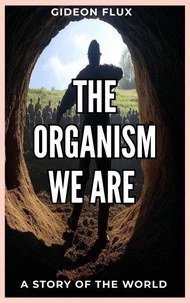On the Physics of Organic Earth. Organic Cosmos, #2
Par :Formats :
Disponible dans votre compte client Decitre ou Furet du Nord dès validation de votre commande. Le format ePub est :
- Compatible avec une lecture sur My Vivlio (smartphone, tablette, ordinateur)
- Compatible avec une lecture sur liseuses Vivlio
- Pour les liseuses autres que Vivlio, vous devez utiliser le logiciel Adobe Digital Edition. Non compatible avec la lecture sur les liseuses Kindle, Remarkable et Sony
 , qui est-ce ?
, qui est-ce ?Notre partenaire de plateforme de lecture numérique où vous retrouverez l'ensemble de vos ebooks gratuitement
Pour en savoir plus sur nos ebooks, consultez notre aide en ligne ici
- FormatePub
- ISBN8230810988
- EAN9798230810988
- Date de parution18/04/2025
- Protection num.pas de protection
- Infos supplémentairesepub
- ÉditeurIndependently Published
Résumé
On the Physics of Organic Earth by Gideon Flux presents a revolutionary metaphysical framework redefining gravity, time, and reality within Coccotunnella perpetua, a living, conscious universe where all entities-cups, humans, planets-are formations of soldiers under 14 lords (e.g., Lord of Time, Gravity, Space). Building on The Organism We Are, the book posits that gravity isn't a physical force but a conscious process driven by the Revolutionary Echo, a chaotic reverberation of lower conscious beings' impulses, causing soldier breakoffs (red dots) that shape existence via human perception-attached (symbiosis, no choice) or detached (conflict, human choice).
Structured in three parts, the book first tackles cosmic phenomena (Pages 6-91). It introduces a conscious gravity theory (Pages 7-23), using a hypothetical seesaw to model how breakoffs tilt human movement (Pages 9-12), with time emerging from their sequence (Pages 13-15). The Echo, not lords, drives randomness, resolving the formation dynamic paradox (Pages 15-21) and applying to systems like orbits (Pages 21-23).
It counters aether comparisons (Pages 24-28), affirming consciousness over mechanics, and resolves physics paradoxes (e.g., Newton's bucket, Fermi Paradox, Pages 33-56) via breakoffs, not physical laws. Part 2 (Pages 57-91) simulates particle motion (e.g., H?O formation, Pages 61-65), contrasting conscious chemistry with quantum mechanics. Part 3 (Pages 92-120) grounds the theory in daily life, reinterpreting traffic, geopolitics, war, disease, poverty, and wealth as conscious gravitational effects (Pages 93-118), shaped by perception's interplay with the Echo.
Structured in three parts, the book first tackles cosmic phenomena (Pages 6-91). It introduces a conscious gravity theory (Pages 7-23), using a hypothetical seesaw to model how breakoffs tilt human movement (Pages 9-12), with time emerging from their sequence (Pages 13-15). The Echo, not lords, drives randomness, resolving the formation dynamic paradox (Pages 15-21) and applying to systems like orbits (Pages 21-23).
It counters aether comparisons (Pages 24-28), affirming consciousness over mechanics, and resolves physics paradoxes (e.g., Newton's bucket, Fermi Paradox, Pages 33-56) via breakoffs, not physical laws. Part 2 (Pages 57-91) simulates particle motion (e.g., H?O formation, Pages 61-65), contrasting conscious chemistry with quantum mechanics. Part 3 (Pages 92-120) grounds the theory in daily life, reinterpreting traffic, geopolitics, war, disease, poverty, and wealth as conscious gravitational effects (Pages 93-118), shaped by perception's interplay with the Echo.
On the Physics of Organic Earth by Gideon Flux presents a revolutionary metaphysical framework redefining gravity, time, and reality within Coccotunnella perpetua, a living, conscious universe where all entities-cups, humans, planets-are formations of soldiers under 14 lords (e.g., Lord of Time, Gravity, Space). Building on The Organism We Are, the book posits that gravity isn't a physical force but a conscious process driven by the Revolutionary Echo, a chaotic reverberation of lower conscious beings' impulses, causing soldier breakoffs (red dots) that shape existence via human perception-attached (symbiosis, no choice) or detached (conflict, human choice).
Structured in three parts, the book first tackles cosmic phenomena (Pages 6-91). It introduces a conscious gravity theory (Pages 7-23), using a hypothetical seesaw to model how breakoffs tilt human movement (Pages 9-12), with time emerging from their sequence (Pages 13-15). The Echo, not lords, drives randomness, resolving the formation dynamic paradox (Pages 15-21) and applying to systems like orbits (Pages 21-23).
It counters aether comparisons (Pages 24-28), affirming consciousness over mechanics, and resolves physics paradoxes (e.g., Newton's bucket, Fermi Paradox, Pages 33-56) via breakoffs, not physical laws. Part 2 (Pages 57-91) simulates particle motion (e.g., H?O formation, Pages 61-65), contrasting conscious chemistry with quantum mechanics. Part 3 (Pages 92-120) grounds the theory in daily life, reinterpreting traffic, geopolitics, war, disease, poverty, and wealth as conscious gravitational effects (Pages 93-118), shaped by perception's interplay with the Echo.
Structured in three parts, the book first tackles cosmic phenomena (Pages 6-91). It introduces a conscious gravity theory (Pages 7-23), using a hypothetical seesaw to model how breakoffs tilt human movement (Pages 9-12), with time emerging from their sequence (Pages 13-15). The Echo, not lords, drives randomness, resolving the formation dynamic paradox (Pages 15-21) and applying to systems like orbits (Pages 21-23).
It counters aether comparisons (Pages 24-28), affirming consciousness over mechanics, and resolves physics paradoxes (e.g., Newton's bucket, Fermi Paradox, Pages 33-56) via breakoffs, not physical laws. Part 2 (Pages 57-91) simulates particle motion (e.g., H?O formation, Pages 61-65), contrasting conscious chemistry with quantum mechanics. Part 3 (Pages 92-120) grounds the theory in daily life, reinterpreting traffic, geopolitics, war, disease, poverty, and wealth as conscious gravitational effects (Pages 93-118), shaped by perception's interplay with the Echo.







